Generating test data for software structural testing using particle swarm optimization
Software is amandatory part of today's life,
and has become more and more important in
current information society. However, its
failure may lead to significanteconomic loss or
threat to life safety. As a consequence, software
qualityhas become a top concern today. Among
the methods of software quality assurance,
software testing has been proven as one of the
effective approachesto ensure and improve
software quality over the past threedecades.
However, as most of the software testing is
being done manually, the workforce and cost
required are accordingly high [1]. In general,
about 50 percent of workforce and cost in the
software development process is spent on
software testing [2]. Considering those reasons,
automated software testing has been evaluated
as an efficient and necessary method in order to
reduce those efforts and costs.
Automated structural test data generation is
becoming the research topic attracting much
interest in automated software testingbecause it
enhances the efficiency while reducing
considerably costs of software testing. In our
paper, we will focus on path coverage test data
generation, considering that almost all structural
test data generation problems can be transformed
to the path coverage test datageneration one.
Moreover, Kernighan and Plauger [3] also pointed
out that path coverage test data generation can
find out more than 65 percent of bugs in the given
program under test (PUT).
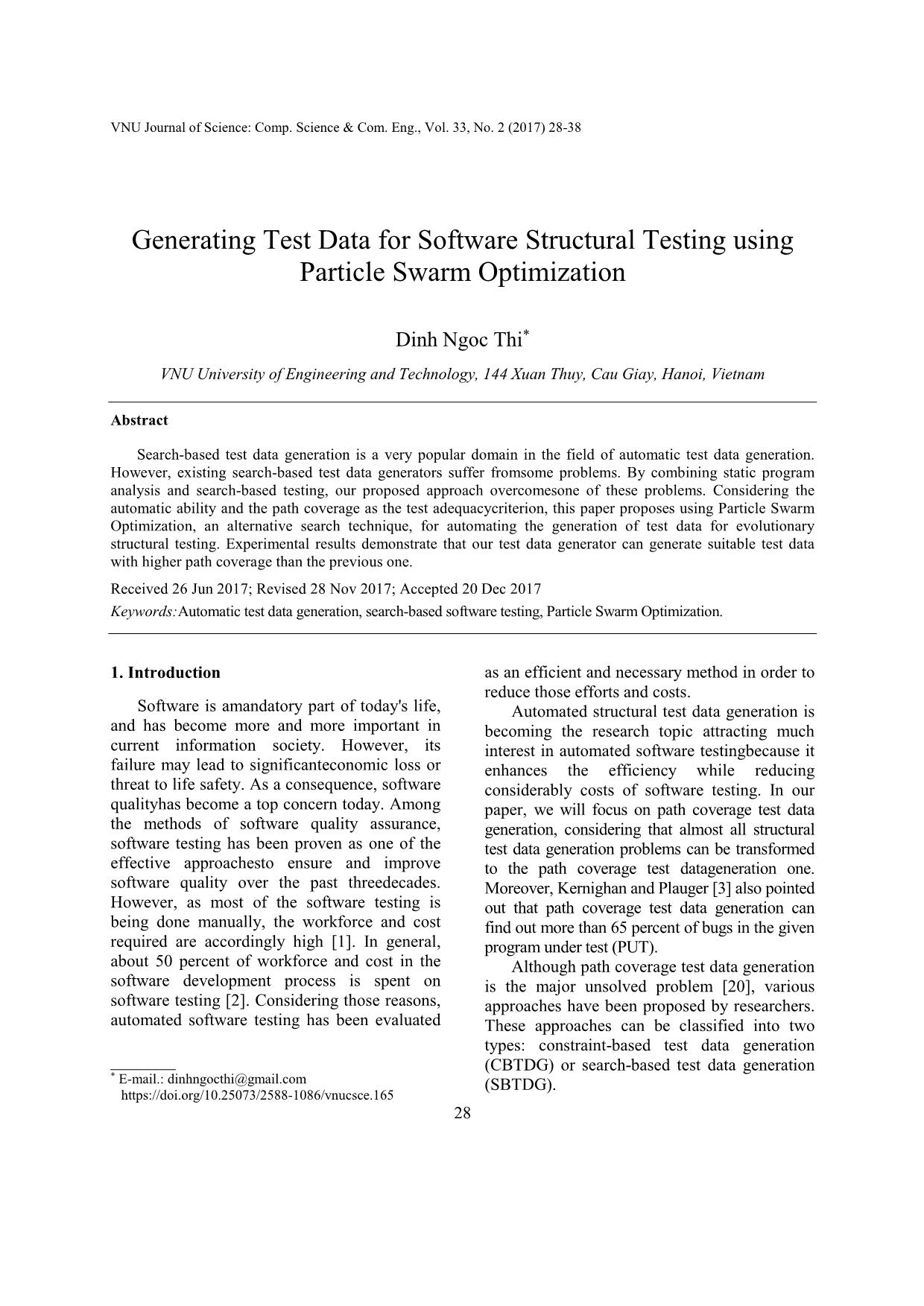
Trang 1
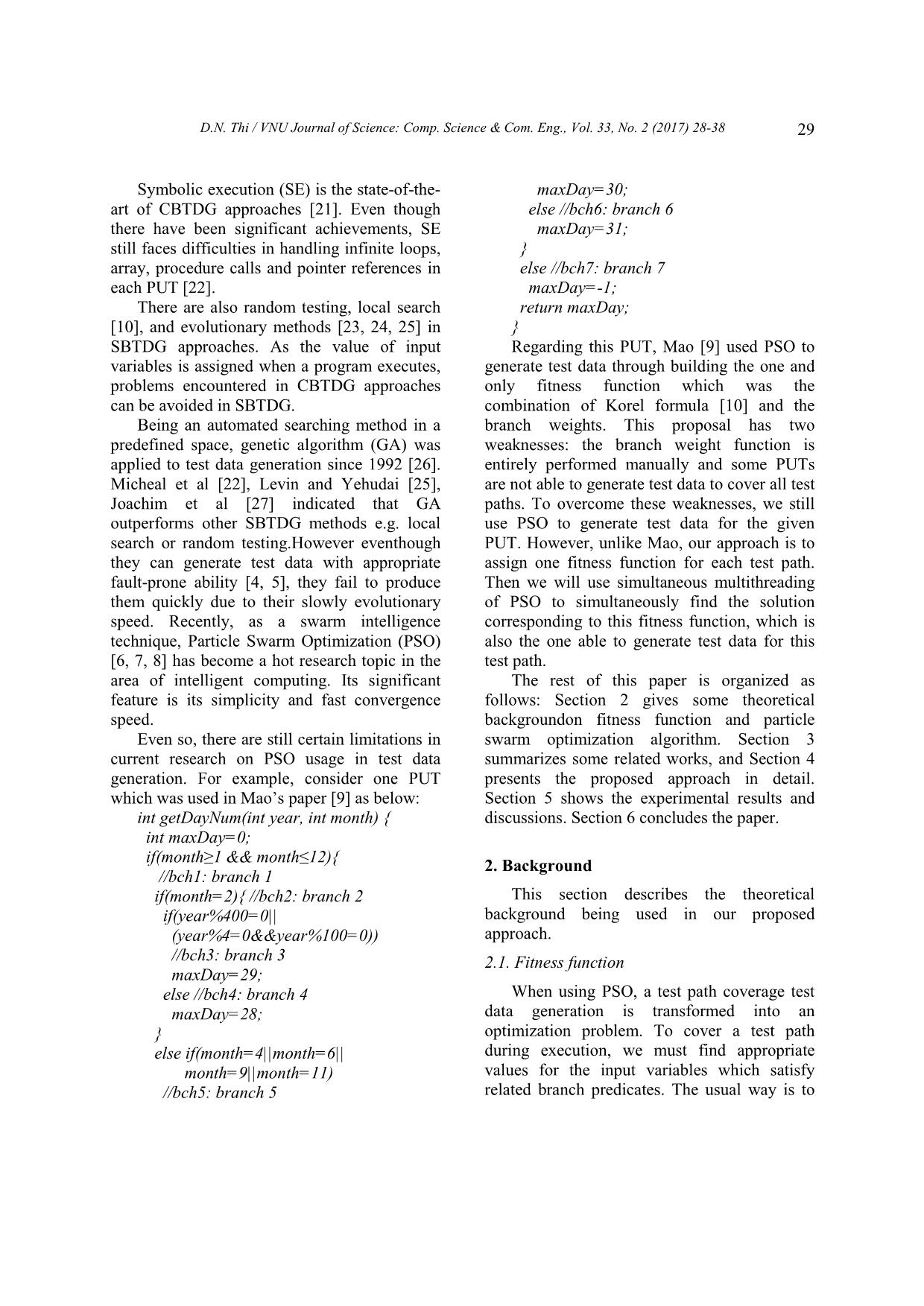
Trang 2
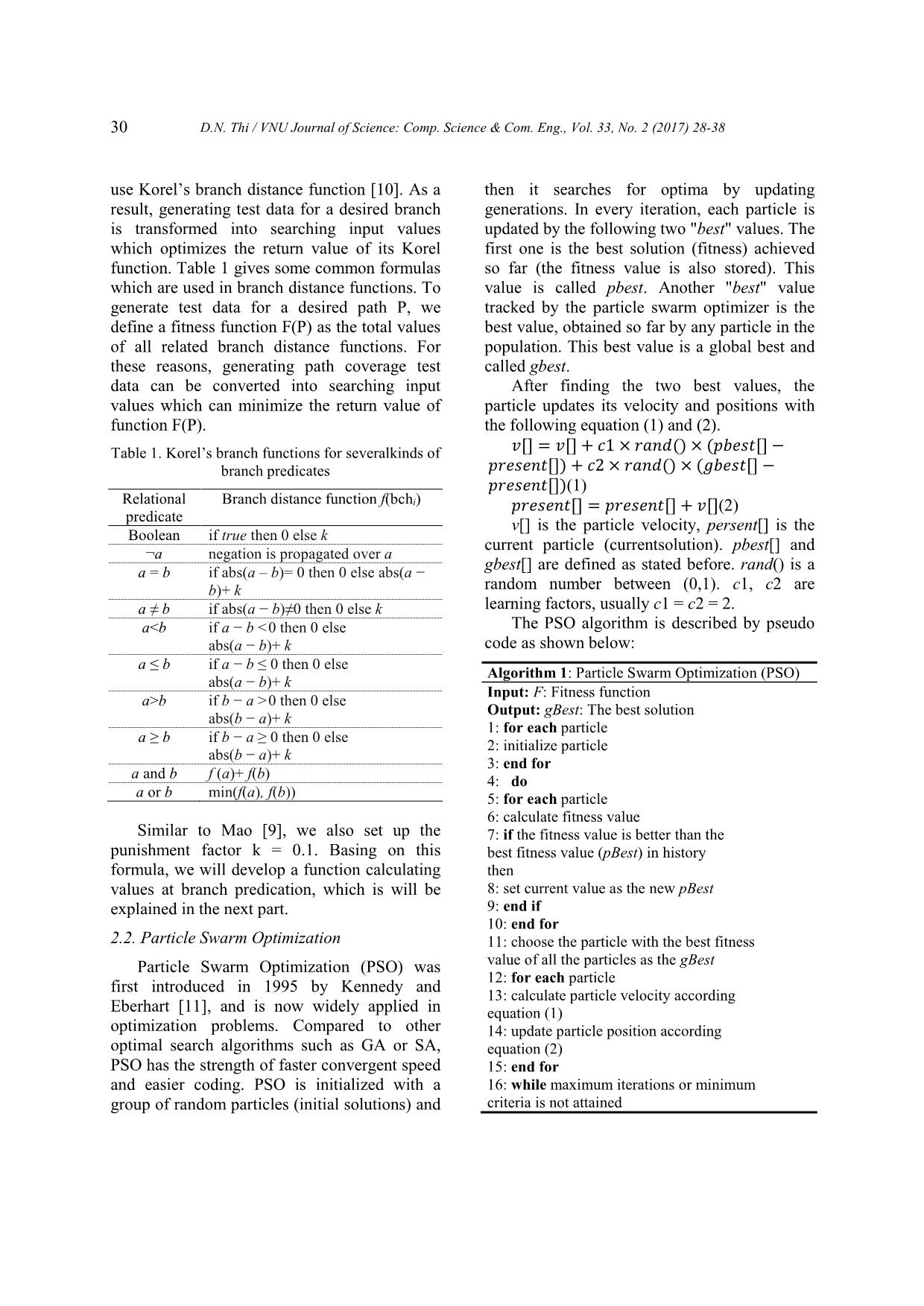
Trang 3
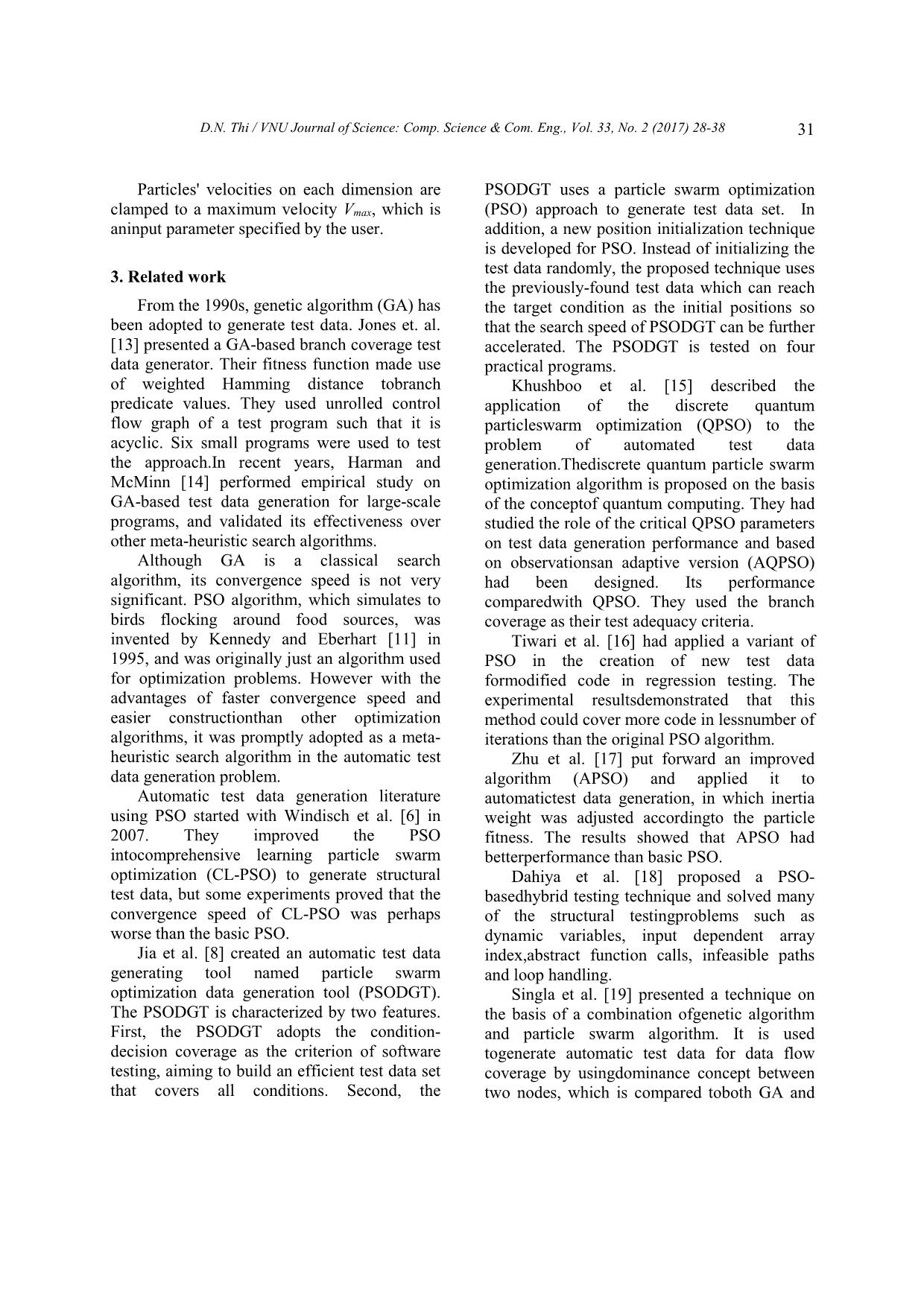
Trang 4
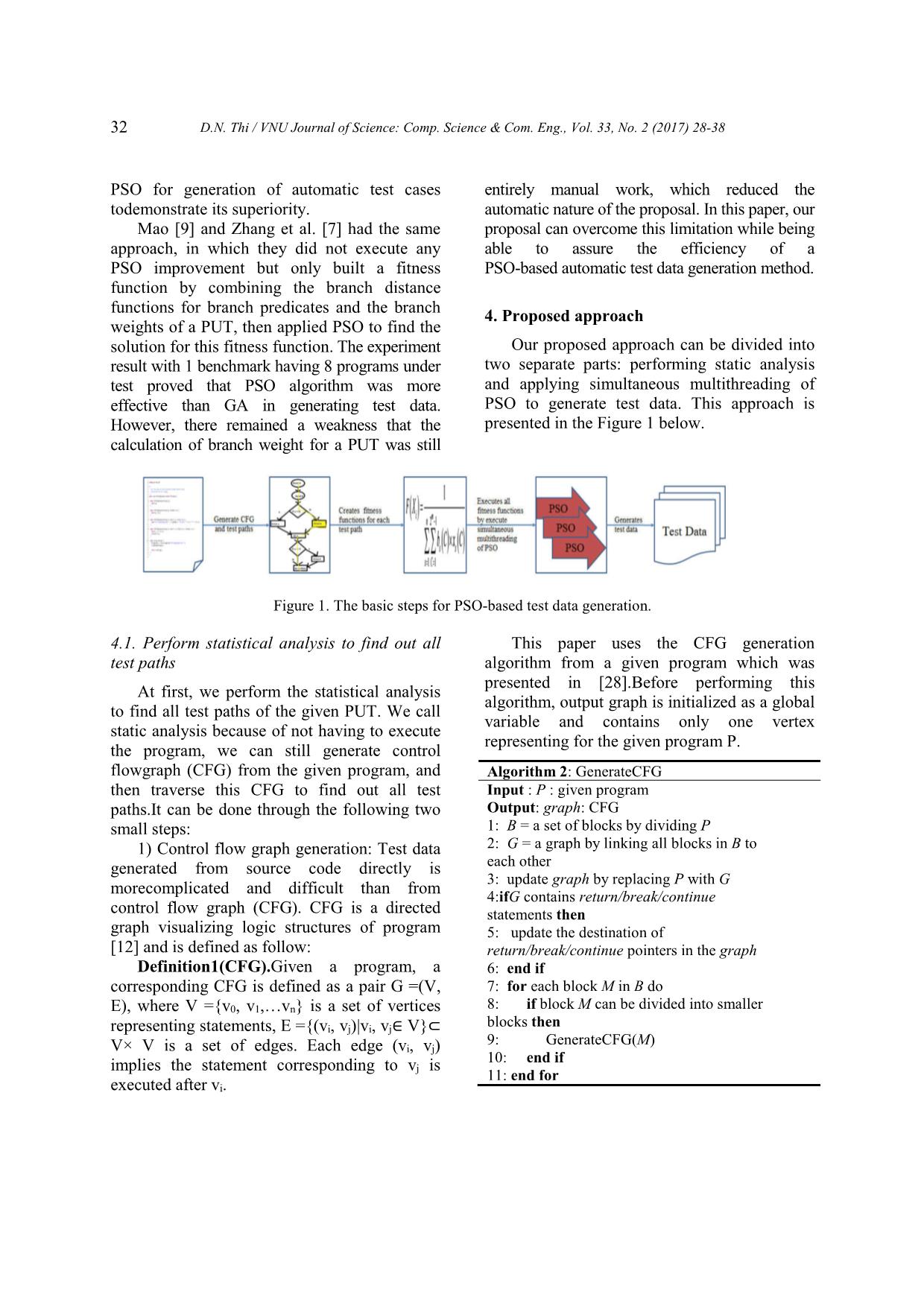
Trang 5
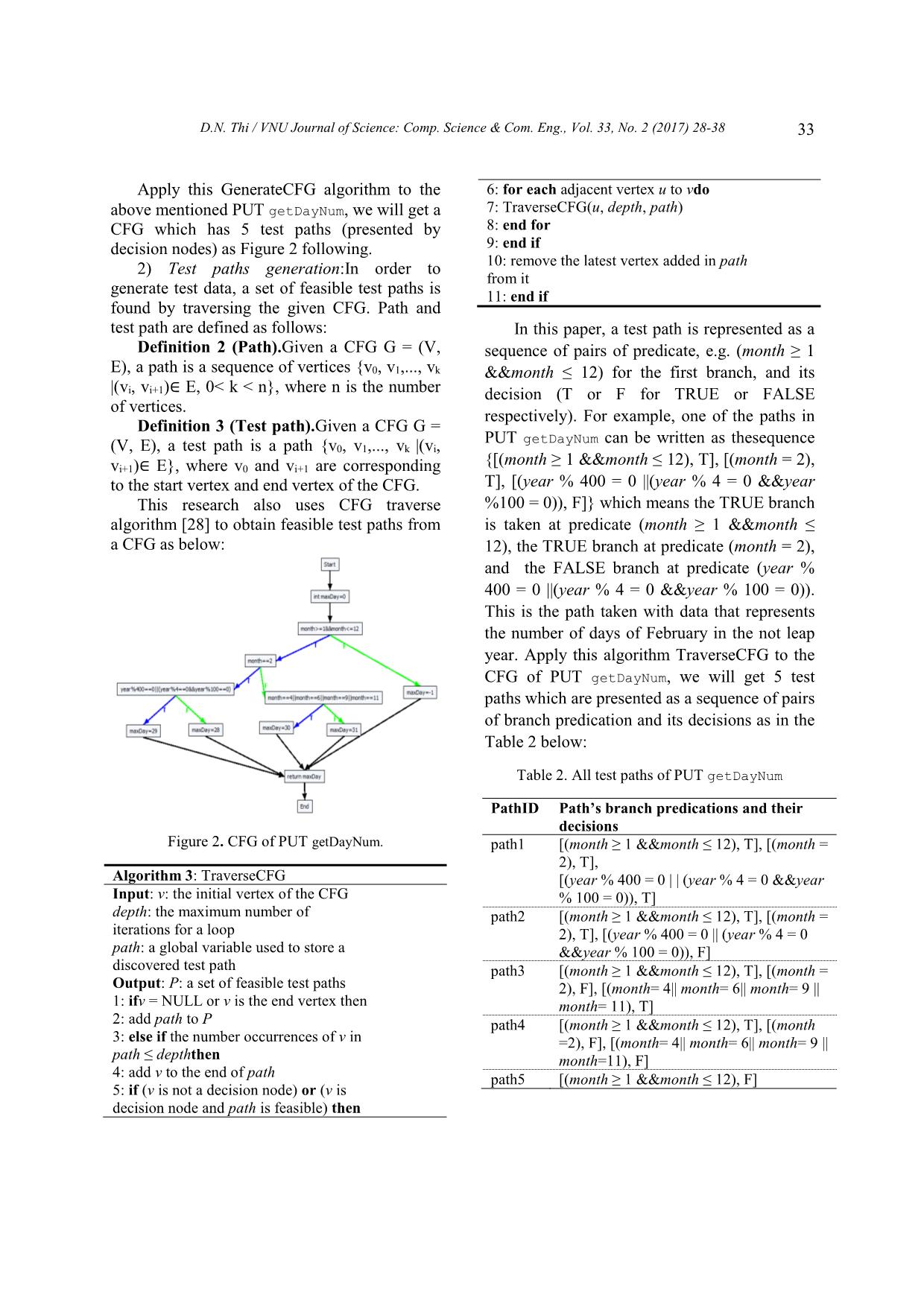
Trang 6
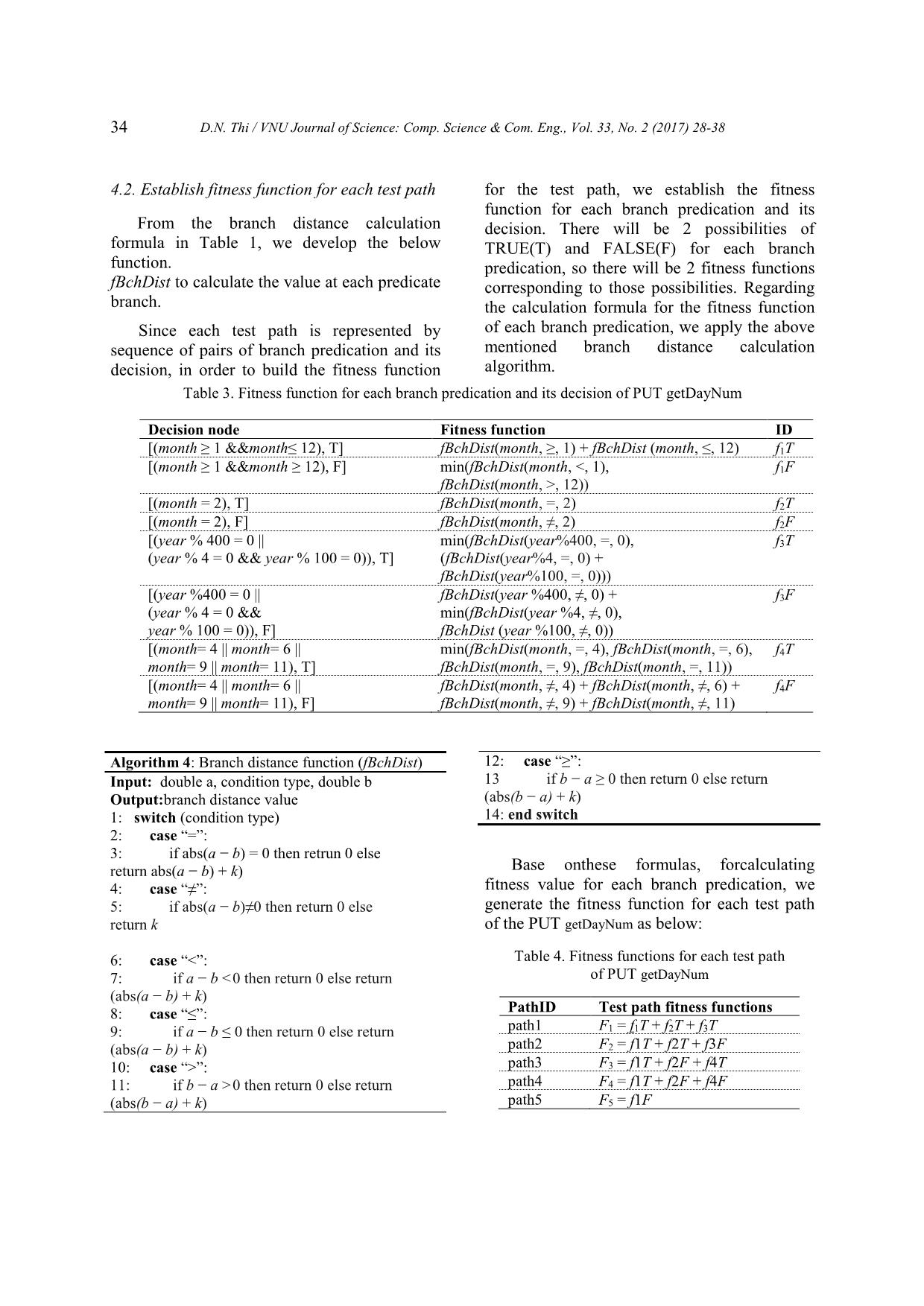
Trang 7
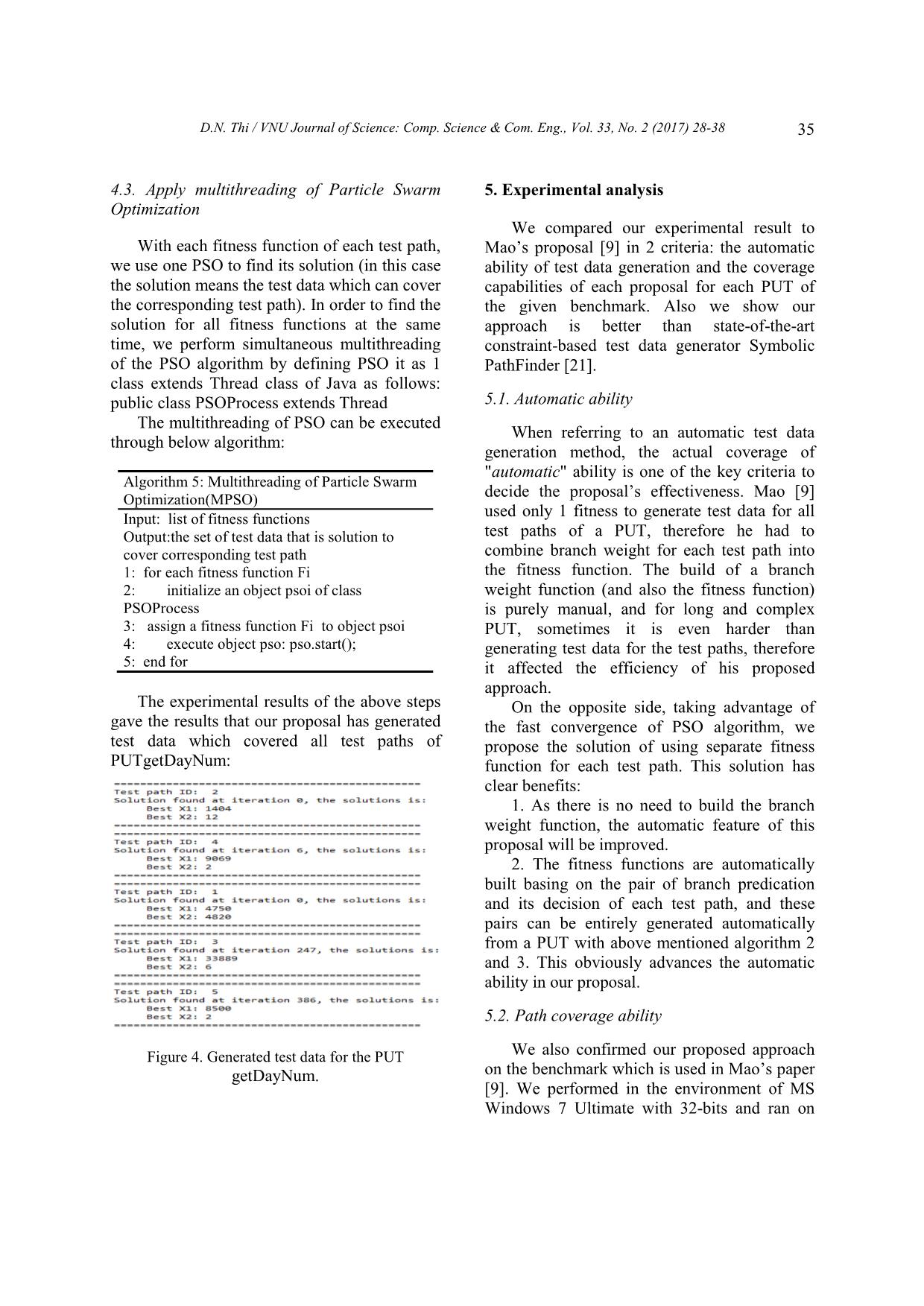
Trang 8
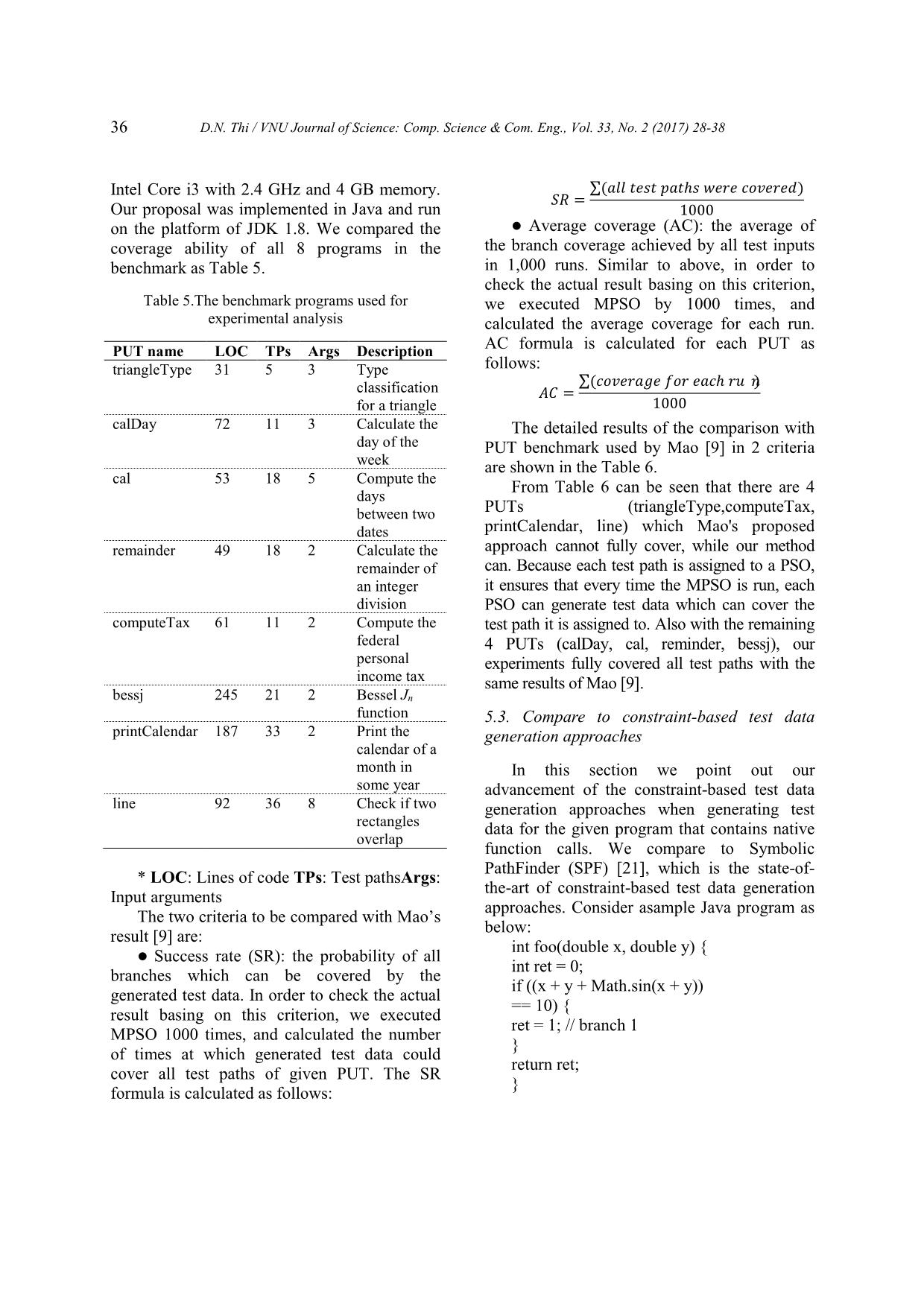
Trang 9

Trang 10
Tải về để xem bản đầy đủ
Tóm tắt nội dung tài liệu: Generating test data for software structural testing using particle swarm optimization
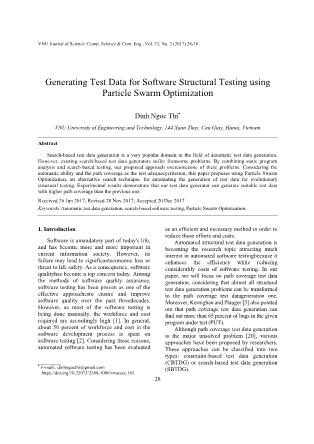
, 4) + fBchDist(month, ≠, 6) + f4F
month= 9 || month= 11), F] fBchDist (month, ≠, 9) + fBchDist(month, ≠, 11)
o
Algorithm 4: Branch distance function (fBchDist) 12: case “≥”:
Input: double a, condition type, double b 13 if b − a ≥ 0 then return 0 else return
Output:branch distance value (abs(b − a) + k)
1: switch (condition type) 14: end switch
2: case “=”:
3: if abs(a − b) = 0 then retrun 0 else
return abs(a − b) + k) Base onthese formulas, forcalculating
4: case “≠”: fitness value for each branch predication, we
5: if abs(a − b)≠0 then return 0 else generate the fitness function for each test path
return k of the PUT getDayNum as below:
6: case “<”: Table 4. Fitness functions for each test path
7: if a − b <0 then return 0 else return of PUT getDayNum
(abs(a − b) + k)
8: case “≤”: PathID Test path fitness functions
9: if a − b ≤ 0 then return 0 else return path1 F1 = f1T + f2T + f3T
(abs(a − b) + k) path2 F2 = f1T + f2T + f3F
10: case “>”: path3 F3 = f1T + f2F + f4T
11: if b − a >0 then return 0 else return path4 F4 = f1T + f2F + f4F
(abs(b − a) + k) path5 F5 = f1F
D.N. Thi / VNU Journal of Science: Comp. Science & Com. Eng., Vol. 33, No. 2 (2017) 28-38 35
4.3. Apply multithreading of Particle Swarm 5. Experimental analysis
Optimization
We compared our experimental result to
With each fitness function of each test path, Mao’s proposal [9] in 2 criteria: the automatic
we use one PSO to find its solution (in this case ability of test data generation and the coverage
the solution means the test data which can cover capabilities of each proposal for each PUT of
the corresponding test path). In order to find the the given benchmark. Also we show our
solution for all fitness functions at the same approach is better than state-of-the-art
time, we perform simultaneous multithreading constraint-based test data generator Symbolic
of the PSO algorithm by defining PSO it as 1 PathFinder [21].
class extends Thread class of Java as follows:
public class PSOProcess extends Thread 5.1. Automatic ability
The multithreading of PSO can be executed
When referring to an automatic test data
through below algorithm:
generation method, the actual coverage of
"automatic" ability is one of the key criteria to
Algorithm 5: Multithreading of Particle Swarm
Optimization(MPSO) decide the proposal’s effectiveness. Mao [9]
Input: list of fitness functions used only 1 fitness to generate test data for all
Output:the set of test data that is solution to test paths of a PUT, therefore he had to
cover corresponding test path combine branch weight for each test path into
1: for each fitness function Fi the fitness function. The build of a branch
2: initialize an object psoi of class weight function (and also the fitness function)
PSOProcess is purely manual, and for long and complex
3: assign a fitness function Fi to object psoi PUT, sometimes it is even harder than
4: execute object pso: pso.start(); generating test data for the test paths, therefore
5: end for it affected the efficiency of his proposed
approach.
The experimental results of the above steps On the opposite side, taking advantage of
gave the results that our proposal has generated the fast convergence of PSO algorithm, we
test data which covered all test paths of propose the solution of using separate fitness
PUTgetDayNum: function for each test path. This solution has
clear benefits:
1. As there is no need to build the branch
weight function, the automatic feature of this
proposal will be improved.
2. The fitness functions are automatically
built basing on the pair of branch predication
and its decision of each test path, and these
pairs can be entirely generated automatically
from a PUT with above mentioned algorithm 2
and 3. This obviously advances the automatic
ability in our proposal.
5.2. Path coverage ability
Figure 4. Generated test data for the PUT We also confirmed our proposed approach
getDayNum. on the benchmark which is used in Mao’s paper
[9]. We performed in the environment of MS
Windows 7 Ultimate with 32-bits and ran on
36 D.N. Thi / VNU Journal of Science: Comp. Science & Com. Eng., Vol. 33, No. 2 (2017) 28-38
Intel Core i3 with 2.4 GHz and 4 GB memory. ∑(��� ���� ���ℎ� ���� �������)
�� =
Our proposal was implemented in Java and run 1000
on the platform of JDK 1.8. We compared the Average coverage (AC): the average of
coverage ability of all 8 programs in the the branch coverage achieved by all test inputs
benchmark as Table 5. in 1,000 runs. Similar to above, in order to
check the actual result basing on this criterion,
Table 5.The benchmark programs used for we executed MPSO by 1000 times, and
experimental analysis calculated the average coverage for each run.
PUT name LOC TPs Args Description AC formula is calculated for each PUT as
triangleType 31 5 3 Type follows:
∑(�������� ��� ���ℎ ���)
classification �� =
for a triangle 1000
calDay 72 11 3 Calculate the The detailed results of the comparison with
day of the PUT benchmark used by Mao [9] in 2 criteria
week are shown in the Table 6.
cal 53 18 5 Compute the From Table 6 can be seen that there are 4
days
between two PUTs (triangleType,computeTax,
dates printCalendar, line) which Mao's proposed
remainder 49 18 2 Calculate the approach cannot fully cover, while our method
remainder of can. Because each test path is assigned to a PSO,
an integer it ensures that every time the MPSO is run, each
division PSO can generate test data which can cover the
computeTax 61 11 2 Compute the test path it is assigned to. Also with the remaining
federal 4 PUTs (calDay, cal, reminder, bessj), our
personal experiments fully covered all test paths with the
income tax same results of Mao [9].
bessj 245 21 2 Bessel Jn
function 5.3. Compare to constraint-based test data
printCalendar 187 33 2 Print the generation approaches
calendar of a
month in In this section we point out our
some year advancement of the constraint-based test data
line 92 36 8 Check if two generation approaches when generating test
rectangles data for the given program that contains native
overlap
function calls. We compare to Symbolic
PathFinder (SPF) [21], which is the state-of-
* LOC: Lines of code TPs: Test pathsArgs:
the-art of constraint-based test data generation
Input arguments
approaches. Consider asample Java program as
The two criteria to be compared with Mao’s
below:
result [9] are:
int foo(double x, double y) {
Success rate (SR): the probability of all
int ret = 0;
branches which can be covered by the
if ((x + y + Math.sin(x + y))
generated test data. In order to check the actual
== 10) {
result basing on this criterion, we executed
ret = 1; // branch 1
MPSO 1000 times, and calculated the number
}
of times at which generated test data could
return ret;
cover all test paths of given PUT. The SR
}
formula is calculated as follows:
D.N. Thi / VNU Journal of Science: Comp. Science & Com. Eng., Vol. 33, No. 2 (2017) 28-38 37
Due to the limitation of the constraint solver abs((x + y + Math.sin(x + y)) - 10). Then using
used in SPF, it cannot solve the condition((x + y PSO to generate test data that satisfies this
+ Math.sin(x + y)) == 10).Because this condition condition, we got the following result:
contains the native function Math.sin(x + y) of the
Java language, SPFis unable to generate test
data which can cover branch 1.
In contrast, by using search-based test data
generation approach, for the condition((x + y +
Math.sin(x + y)) == 10), we appliedKorel’s
Figure 5. Generated test data for the condition which
formulain Table 1 to create fitness functionf1T = contains native function.
Table 6. Comparison between Mao's approach and MPSO
Success rate (%) Average coverage (%)
Program under test
Mao[9]’s PSO MPSO Mao[9]’s PSO MPSO
triangleType 99.80 100.0 99.94 100.0
calDay 100.0 100.0 100.0 100.0
cal 100.0 100.0 100.0 100.0
remainder 100.0 100.0 100.0 100.0
computeTax 99.80 100.0 99.98 100.0
bessj 100.0 100.0 100.0 100.0
printCalendar 99.10 100.0 99.72 100.0
line 99.20 100.0 99.86 100.0
6. Conclusion apply this proposal for programs not only
inacademics but also in industry.
This paper has introduced and evaluated a
combination static program analysis and PSO References
approach for evolutionary structural testing. We
proposed a method which uses a fitness [1] B. Antonia, “Software Testing Research:
Achievements, Challenges, Dreams”, Future of
function for each test path of a PUT, and then Software Engineering, pp. 85-103. IEEE
executed those PSOs simultaneously in order to Computer Society, Washington (2007).
generate test data to cover test paths of a PUT. [2] G. J. Myers, “The Art of Software Testing”, 2nd
The experimental result proves that our edition, John Wiley & Sons Inc (2004).
proposal is more effective than Mao’s [9] test [3] B. W. Kernighan and P. J. Plauger, “The Elements
data generation method using PSO in terms of of Programming Style”, McGraw-Hill, Inc, New
both automatic and coverage ability for a PUT. York (1982).
Our approach also addressed a limitation of [4] M. A. Ahmed and I. Hermadi, “GA-based Multiple
constraint-based test data generation Paths Test Data Generator”, Computers &
approaches, which generate test data for Operations Research, vol. 35, pp 3107-3124 (2008).
conditions that contain native functions. [5] J. Malburg and G. Fraser, “Search-based testing
using constraint-based mutation”, Journal
As future works, we will continue to extend Software Testing, Verification & Reliability, vol.
our proposal to be applicable to many kinds of 24(6), 472-495 (2014).
UTs, such as PUTs which contain calls to other [6] A.Windisch and S.Wappler, “Applying particle
native functions or PUTs that handle string swarm optimization to software testing”,
operations or complex data structures. In Proceedings of the 9th Annual Conference on
addition, further research is needed to be able to Genetic and Evolutionary Computation
(GECCO’07), pp. 1121–1128 (2007).
38 D.N. Thi / VNU Journal of Science: Comp. Science & Com. Eng., Vol. 33, No. 2 (2017) 28-38
[7] Yanli Zhang, Aiguo Li, "Automatic Generating generation for data flow coverage with dominance
All-Path Test Data of a Program Based on PSO", concepts”, Int. J. Adv. Sci. Technol. 37 (2011).
vol. 04, pp. 189-193, 2009, [20] E. J. Weyuker, “The applicability of program
doi:10.1109/WCSE.2009.98. schema results to programs”, International Journal
[8] Ya-Hui Jia, Wei-Neng Chen, Jun Zhang, Jing-Jing of Parallel Programming, vol. 8, 387-403 (1979).
Li, “Generating Software Test Data by Particle [21] C. S. Pasareanu, W. Visser, D. Bushnell, J.
Swarm Optimization”, Proceedings of 10th Geldenhuys, P. Mehlitz, N. Rungta, “Symbolic
International Conference, SEAL 2014, Dunedin, PathFinder: Integrating Symbolic Execution with
New Zealand, December 15-18, 2014. Model Checking for Java Bytecode Analysis”,
[9] C.Mao, “Generating Test Data for Software”, Arabian Automated Software Engineering Journal,
Journal for Science and Engineering Structural Testing Springer (2013).
Based on Particle Swarm Optimization, vol 39, issue 6, [22] G. M. Michael, M. Schatz, “Generating software
pp 4593–4607 (June 2014). test data by evolution”, IEEE Transactions on
[10] B. Korel, “Automated software test data Software Engineering, vol. 27, 1085-1110 (2001).
generation”, IEEE Transactions on Software [23] J. Wegener, A. Baresel, and H. Sthamer,
Engineering, vol. 16, 870-879 (1990). “Evolutionary test environment for automatic
[11] J.Kennedy, and R.Eberhart, “Particle swam structural testing”, Information and Software
optimization”, Proceedings of IEEE International Technology, vol. 43, 841-854 (2001).
Conference on Neural Networks (ICNN’95), pp. [24] J. Wegener, B. Kerstin, and P. Hartmut,
1942–1948 (1995) “Automatic Test Data Generation For Structural
[12] Robert Gold, “Control flow graph and code Testing Of Embedded Software Systems By
coverage”, Int. J. Appl. Math. Comput. Sci., Vol. Evolutionary Testing”, Genetic and Evolutionary
20, No. 4, 2010, pp. 739-749 Computation Conference. Morgan Kaufmann
[13] Bryan F. Jones, Harmen-Hinrich Sthamer, and Publishers Inc. (2002).
D.E. Eyres, “Automatic structural testing using [25] S. Levin and A. Yehudai, ” Evolutionary Testing:
genetic algorithms”, Software Engineering, A Case Study”, Hardware and Software,
11(5):299–306, September 1996. Verification and Testing, 155-165 (2007).
[14] M.Harman, P.McMinn, “A theoretical and [26] S. Xanthakis, C. Ellis, C. Skourlas, A. Le Gall, S.
empirical study of search-based testing: local, Katsikas, and K. Karapoulios, “Application of
global, and hybrid search”, IEEE Trans. Softw. genetic algorithms to software testing
Eng. 36(2), 226–247 (2010) (Application des algorithmes genetiques au test
[15] Agrawal K., Srivastava G, “Towards software test des logiciels)”, 5th International Conference on
data generation using discrete quantum particle Software Engineering and its Applications, pp.
swarm optimization”, ISEC, Mysore, India 625--636. Toulouse, France (1992).
(February 2010). [27] W. Joachim, Andr, Baresel, and S. Harmen,
[16] S. Tiwari, K.K. Mishra, A.K. Misra, “Test case “Suitability of Evolutionary Algorithms for
generation for modified code using a variant of Evolutionary Testing”, 26th International
particle swarm optimization (PSO) Algorithm Computer Software and Applications Conference
[C]”, Proceedings of the Tenth IEEE International on Prolonging Software Life: Development and
Conference on Information Technology: New Redevelopment. IEEE Computer Society,
Generations (ITNG), 2013, pp. 363–368. Washington (2002).
[17] X.M. Zhu, X.F. Yang, “Software test data [28] Duc-Anh Nguyen, Pham Ngoc Hung, Viet-Ha
generation automatically based on improved Nguyen, "A method for automated unit testing of
adaptive particle swarm optimizer”, Proceedings C programs", Proceedings of 2016 3rd National
of the International Conference on Computational Foundation for Science and Technology
and Information Sciences, 2010, pp. 1300–1303. Development Conference on Information and
[18] S. Dahiya, J. Chhabra, S. Kumar., “PSO based Computer Science (NICS), 2016, pp. 17-22k.
pseudo dynamic method for automated test case
generation using interpreter”, Proceedings of the
Second International Conference on Advances in
Swarm intelligence, 2011, pp. 147–156.
[19] S. Singla, D. Kumar, H.M. Rai, P. Singla, “A
hybrid PSO approach to automate test data
File đính kèm:
 generating_test_data_for_software_structural_testing_using_p.pdf
generating_test_data_for_software_structural_testing_using_p.pdf

